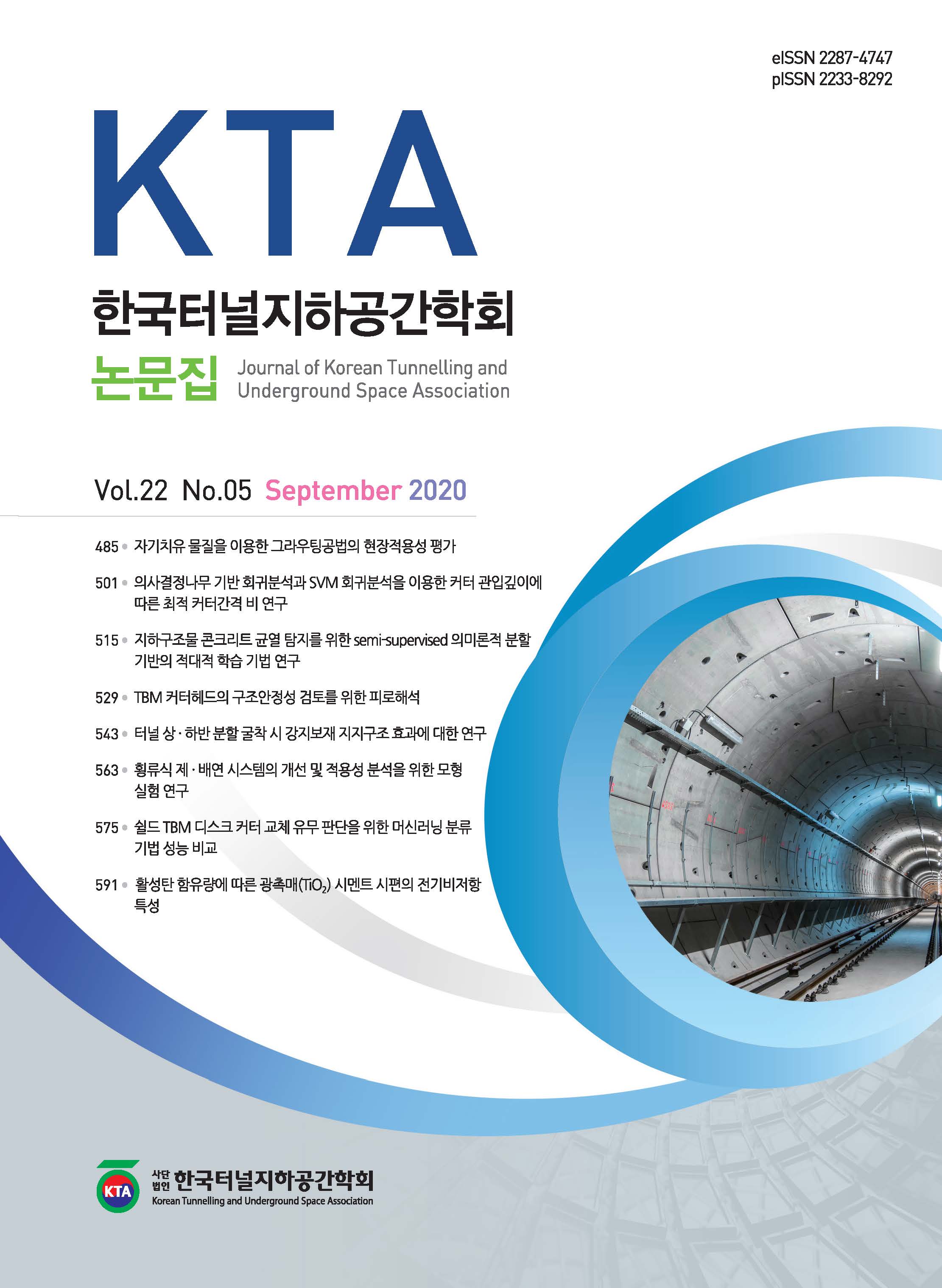- 권한신청
- P-ISSN2233-8292
- E-ISSN2287-4747
- KCI
 ISSN : 2233-8292
ISSN : 2233-8292
지중구조물 균열을 통한 토립자 유출 및 지반함몰 특성 연구
Study on the discharge of soil particles and ground collapse through cracks in underground structures
김강현 (건국대학교)
신종호 (건국대학교)
초록
도시기반시설인 지중관거의 노후화가 심화되면서, 최근 도심지의 관거 주변에서 공동발생과 지반함몰 사례가 빈번하게 보고되고 있다. 지중관거 균열과 관련된 공동발생 및 지반함몰에 대해 많은 연구가 수행된 바 있으나, 기존 연구내용은 주로 관거의 균열 발생원인과 지반침하 거동에 집중되어 있다. 본 연구에서는 관거의 균열을 통한 지하수와 토립자 유출특성과 공동발생 메커니즘을 조사하였다. 또한, 토사유출로 인해 공동이 발생하고 지반함몰로 발전해가는 과정에 대한 가설을 수립하여 토립자 유출의 수리적 특성을 규명하고자 하였다. 관거 균열을 통한 토립자 유출 및 공동발생 메커니즘 규명을 위해 실내모형실험을 수행하였다. 모형실험으로부터 관거 균열을 통해 유출된 토립자를 측정하고, 실험과정을 영상촬영하여 PIV 분석을 통해 입자의 이동특성을조사하였다. 본 연구를 통해 지중에서 발생하는 토립자의 이동, 공동발생 및 지반함몰 거동은 근본적으로 지하수의 이동에 의해 발생하는 것이며, 균열 위치와 관거 형상에 영향을 받음을 확인하였다.
- keywords
- Underground structure, Crack, Groundwater, Soil particle, Ground collapse, 지중구조물, 균열, 지하수, 토립자, 지반함몰
Abstract
Recently, in urban areas, cavities and ground collapse adjacent to underground structures are frequently reported. Several studies on the cavity generation by structure cracks have been made, however they are focused on the cause of cracks and settlement of the ground. In this paper, soil particle and groundwater discharge through pipe cracks and cavity generation mechanism are investigated. The theoretical analysis of the groundwater, which is the main factor of the drainage of the soil particles, and the particle transport mechanism and flow characteristics were investigated. An experimental model test was carried out to identify the mechanism of cavity generation by underground buried pipe cracks. The soil particle weight of discharge through the cracks, and the movement characteristics of the particles were analyzed using PIV. In this study, it is clearly identified that soil particle movements, cavity generation and ground collapse that occur in the ground are basically caused by the movement of groundwater.
- keywords
- Underground structure, Crack, Groundwater, Soil particle, Ground collapse, 지중구조물, 균열, 지하수, 토립자, 지반함몰
참고문헌
1. Choi, S.K., Baek, S.H., An, J.B., Kwon, T.H. (2016). “Geotechnical investigation on causes and mitigation of ground subsidence during underground structure construction”, Journal of Korean Tunnelling and Underground Space Association, Vol. 18, No. 2, pp. 143-154.
2. Davies, J.P., Clarke, B.A., Whiter, J.T., Cunningham, R.J. (2001a). “Factors influencing the structural deterioration and collapse of rigid sewer pipes”, Urban Water, Vol. 3, No. 1-2, pp. 73-89.
3. Davies, J.P., Clarke, B.A., Whiter, J.T., Cunningham, R.J., Leidi, A. (2001b). “The structural condition of rigid sewer pipes: a statistical investigation”, Urban Water, Vol. 3, No, 4. pp. 277-286.
4. Dirksen, J., Baars, E.J., Langeveld, J.G., Clemens, F.H.L.R. (2012). “Settlement as a driver for sewer rehabilitation”, Water Science and Technology, Vol. 66, No. 7, pp. 1534-1539.
5. Guo, S., Shao, Y., Zhang, T., Zhu, D.Z., Zhang, Y. (2013b), “Physical modeling on sand erosion around defective sewer pipes under the influence of groundwater”, Journal of Hydraulic Engineering, Vol. 139, No. 12, pp. 1247-1257.
6. Guo, S., Yang, Y., Zhang, Y. (2017), “An approximate model on three-dimensional groundwater infiltration in sewer systems”, Water Science and Technology, Vol. 75, No. 2, pp. 306-312.
7. Guo, S., Zhang, T., Zhang, Y., Zhu, D.Z. (2013a), “An approximate solution for two-dimensional groundwater infiltration in sewer systems”, Water Science and Technology, Vol. 67, No. 2, pp. 347-352.
8. Jones, G.M.A. (1984), “The structural deterioration of sewers”, Proceedings of the International Conference on the Planning, Construction, Maintenance & Operation of Sewerage Systems, Vol. 12, Reading, pp. 14.
9. Karmaker, T., Dutta, S. (2013), “Modeling seepage erosion and bank retreat in a composite river bank”, Journal of Hydrology, Vol. 476, pp. 178-187.
10. Kim, H.J., Park N.H., Kim, K.H., Shin, J.H. (2017), “Collapse mechanism of tunnel below underground structure”, Proceedings of the World Tunnel Congress 2017, Bergen.
11. Kim, H.J., Park, J.M., Shin, J.H. (2019), “Flow behaviour and piping potential at the soil-structure interface”, Geotechnique, Vol. 69, No. 1, pp. 79-84.
12. Kim, Y.K., Nam, K.T., Kim, H.J., Shin, J.H. (2018), “An investigation on the ground collapse mechanism induced by cracks in a nonpressurized buried pipe through model tests”, Journal of Korean Tunnelling and Underground Space Association, Vol. 20, No. 2, pp. 235-253.
13. Kuwano, R., Horii, T., Yamauchi, K., Kohashi, H. (2010a), “Formation of subsurface cavity and loosening due to defected old sewer pipe”, Japanese Geotechnical Journal, Vol. 5, No. 2, pp. 349-361.
14. Kuwano, R., Sato, M., Sera, R. (2010b), “Study on the detection of underground cavity and ground loosening for the prevention of ground cave-in accident”, Japanese Geotechnical Journal, Vol. 5, No. 2, pp. 219-229.
15. KWWA (2011), Sewerage facility standard, Korea Water and Wastewater Association, pp. 107-274.
16. Law, T.C.M., Moore, I.D. (2007), “Numerical modeling of tight fitting flexible liner in damaged sewer under earth loads”, Tunnelling and Underground Space Technology, Vol. 22, No. 5-6, pp. 655-665.
17. Ministry of Land, Infrastructure and Transport (2015), Safety management maunal of ground subsidence (collapse).
18. Mitchell, J.K., Soga, K. (2005), Fundamentals of soil behavior (Vol. 3), New York: John Wiley & Sons, New York, pp. 465-522.
19. Mukunoki, T., Yoji, K., Hino, K. (2010), “Evaluation of unsaturated flow in cover soil with respect to different density and grain properties on landfill”, Japanese Geotechnical Journal, Vol. 5, No. 2, pp. 325-337.
20. Mukunoki, T., Kumano, N., Otani, J., Kuwano, R. (2009), “Visualization of three dimensional failure in sand due to water inflow and soil drainage from defective underground pipe using X-ray CT”, Soils and Foundations, Vol. 49, No. 6, pp. 959-968.
21. Sato, M., Kuwano, R. (2015), “Influence of location of subsurface structures on development of underground cavities induced by internal erosion”, Soils and Foundations, Vol. 55, No. 4, pp. 829-840.
- 다운로드 수
- 조회수
- 0KCI 피인용수
- 0WOS 피인용수

